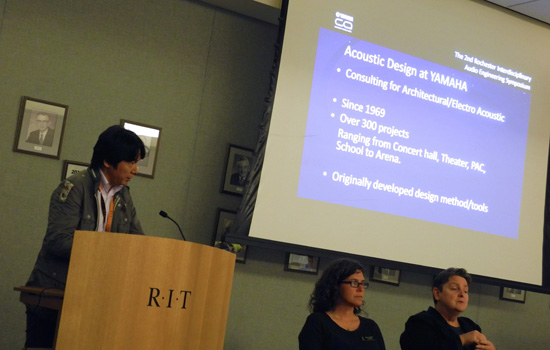Audio enhancement discussed at annual symposium
Yamaha designers and university researchers discuss how audio is integrated into modern performance spaces
Photo by M. Cometa
Several prominent researchers participated in the recent Rochester Interdisciplinary Audio Engineering Symposium at RIT including Yamaha Corp.’s Hideo Miyazaki. Presenters provided information about top trends and systems in audio engineering.
How performance spaces are designed influences sound quality for the audience and performers. Controlling elements of both architecture and acoustics could mean the difference between distracting feedback and distinct melodies, said Yamaha Corp. researcher Hideo Miyazaki. He described how treated wood used for the flooring of Yamaha Hall in Tokyo, Japan, was just one small way design and technology influenced sound, significantly decreasing echoes and providing a richer, musical tone during performances.
This attention to how sound is being enhanced, manipulated and captured as it reverberates from ceilings to floors was one of the topics at the recent Rochester Interdisciplinary Audio Engineering Symposium “Immersive Sound and Music Information” at RIT on Aug. 28. More than 50 area engineers, researchers, professors and students attended to learn more about trends in audio equipment development—the science and technology of sound systems—and how these systems enhance the audio experiences for both artists and listeners. It also highlighted how audio engineers will be necessary to complement growth in gaming, film and other popular media and entertainment businesses.
“People have a passion for music, and today’s audio engineers are looking into the best ways to heighten performances and listening devices from equipment to understanding the influence of materials on sound in auditorium settings,” said Michael Eastman, department chair of RIT’s electrical, computer and telecommunications engineering technology program. “This symposium is about how sound impacts our lives and is a way for us to understand the complexity of audio.”
Companies such as Yamaha are addressing that complexity in some of today’s non-traditionally designed auditoriums using Active Field Control, the company’s system of electroacoustic enhancements and design tools. AFC actively uses the architectural acoustic feedback system in an auditorium through filtering devices, source and receiver positioning to control reverberation.
“Sounds on stages are bigger, brighter and clearer, good for the audience and the performers,” said Miyazaki, who with colleague Takayuki Watanabe, acoustical engineer and researcher at Yamaha Corp., have integrated the system into more than 100 projects around the world, including most recently, the National Opera House in Warsaw, Poland. The team was able to improve acoustics in the building, originally erected in 1833, while preserving its historic architecture.
Universities with programs in audio engineering are also pushing how systems incorporate the latest technology. Researchers from RIT, the University of Rochester and Seoul National University discussed technology and how signal-processing techniques are being introduced to address audio distortion using Gorilla Glass, plastic and Styrofoam as comparative options to test for different effects on the resonant modes.
Finger Lakes Community College introduced the group to its growing program in music recording technology that emphasizes the creative aspects of the recording process. Students receive a two-year degree and are prepared to enter into 4-year programs or the workforce with skills in managing state-of-the-art recording equipment and musical performance, said Robert Potter, recording studio manager, Finger Lakes Community College. He and faculty member Jonathan Belec shared an overview of the program and the facilities.
“The studios are the students’ classroom, and they are in them getting hands-on experience in their first semester,” he said of the facilities and equipment at the college that mirrors systems found in today’s recording studios. One of the recording areas is 1,600 square feet of space, large enough for orchestral-size ensembles. “But we also teach them it’s about the ear, not just the gear.”
Participants attending the symposium were from regional school districts, local audio companies, and corporations using audio technologies in products such as toys, movie systems and media. Started last year by Sungyoung Kim, assistant professor of audio engineering, the event is hosted by the department, part of RIT’s College of Applied Science and Technology. Within CAST, the electrical, computer and telecommunications engineering technology program features an option in audio technology specifically about audio production, signal processing and critical listening.
“In our program we teach the students not only how to design audio equipment, but also how to listen critically which is an important differentiator for the audio industry,” said Kim.







